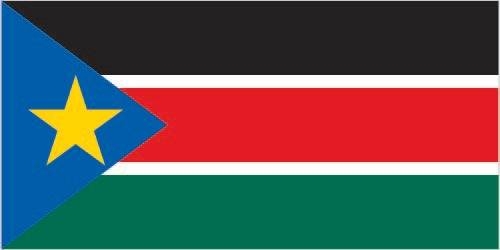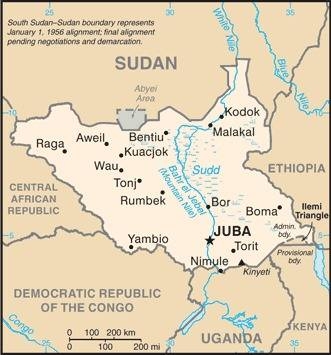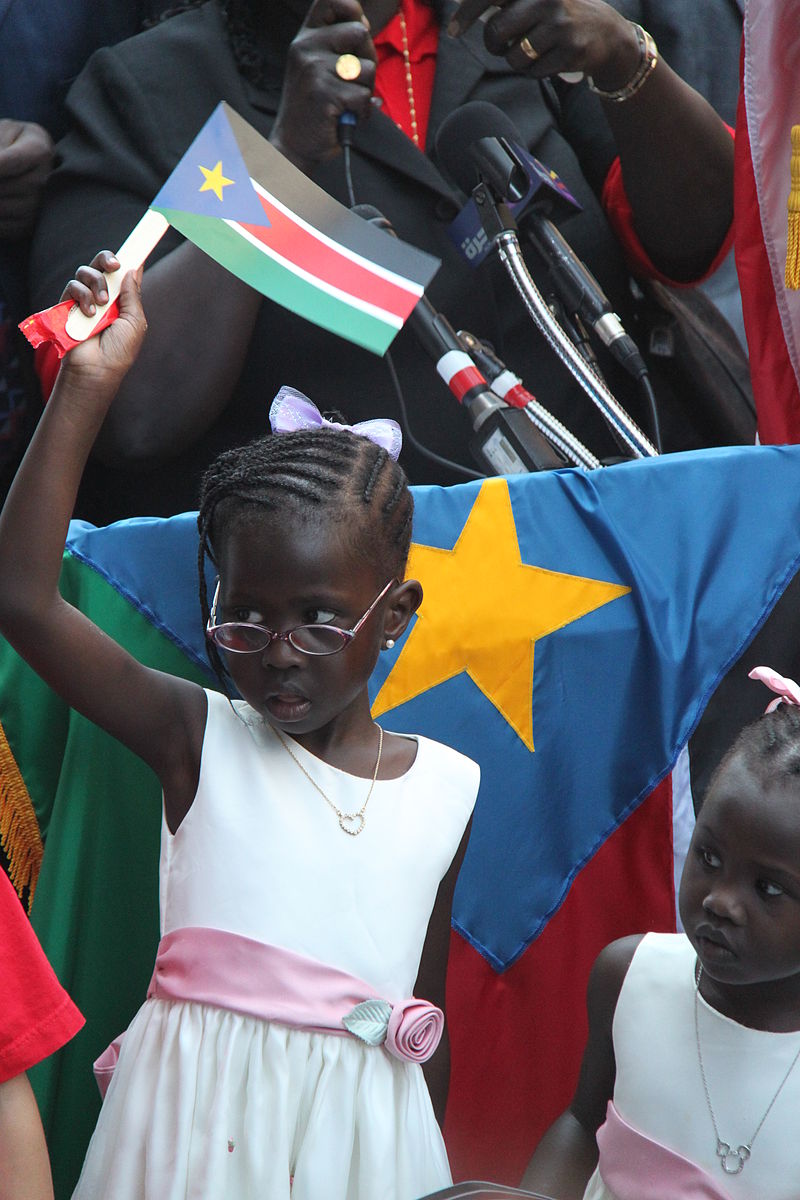223 South Sudan

Three equal horizontal bands of black (top), red, and green; the red band is edged in white. A blue isosceles triangle based on the hoist side contains a gold, five-pointed star. Black represents the people of South Sudan, red the blood shed in the struggle for freedom, green the verdant land, and blue the waters of the Nile. The gold star represents the unity of the states making up South Sudan.
Flag courtesy of the CIA World Factbook

Map courtesy of the CIA World Factbook

A South Sudanese girl at independence festivities
Government
According to Britannica, the creation of the semiautonomous region of southern Sudan was provided for by the 2005 Comprehensive Peace Agreement (CPA) that ended the long-running civil war between the north and the south. The region was administered under the constitution for southern Sudan, promulgated in December 2005, as well as the country’s national interim constitution, promulgated in July 2005. The latter document provided for the handling of any conflicts that might occur between the two concurrent levels of government. Both documents were superseded by the transitional constitution prepared for governing South Sudan upon its 2011 secession from Sudan.
Under the 2011 transitional constitution, South Sudan was a republic. Executive power was vested in the president and the vice president, who was appointed by the president. Upon independence, the directly elected incumbent president of the southern Sudan region became president of the country for a four-year term. Legislative power was bicameral, comprising the National Legislative Assembly (NLA) and the Council of States. Upon independence, the NLA body consisted of members of the previous regional legislative body, the South Sudan Legislative Assembly, and South Sudanese who had seats in Sudan’s National Assembly. The majority of NLA members were directly elected; the rest were elected from closed lists to ensure proportional representation for women and various other groups. Upon independence, the Council of States consisted of all South Sudanese who had been elected by state legislatures to seats in Sudan’s Council of States, as well as 20 members appointed by South Sudan’s president. NLA and Council of States members were to serve four-year terms.
Following the civil war that broke out in December 2013, a peace agreement signed in August 2015 provided for the creation of a transitional power-sharing government that would include members of the current administration as well as members from the rebels. It was implemented in April 2016 and was intended to function for 30 months, with, among its tasks, the goal of organizing elections 60 days prior to the end of the transitional period. The incumbent president remained in place and appointed a first vice president, selected from the rebel group, in accordance with the terms of the peace agreement. After the creation of the transitional government, the administration had 90 days to transform the National Legislative Assembly into the Transitional National Legislative Assembly, which included the members of the former plus an additional 68 members: 50 from the South Sudan Armed Opposition, 1 former detainee, and 17 from other political parties. The other legislative body, the Council of States, remained unchanged in the new transitional government.
For administrative purposes, South Sudan is divided into states. At independence there had been 10 states, but a December 2015 decree by the president abolished them and replaced them with 28 new states. The new administrative structure was highly controversial, as it interfered with the power-sharing arrangements as outlined in the fragile peace agreement signed by the government and rebel forces in August 2015.
The constitution for South Sudan provides for an independent judiciary. The Supreme Court is the highest court. The country also has three Courts of Appeal, and each state has a High Court, County Courts, and town and city courts.
South Sudan Civil Aviation Authority (SSCAA)
South Sudan Civil Aviation Authority (SSCAA) was established in 2006 after the CPA Agreement during Unity Government as the directorate of Air Transport under Sudan Civil Aviation Authority, later after independent of South Sudan in 2011, SSCAA was officially formed and recognized by ICAO has its 193rd Member and key aviation player in accordance with the requirements and developments in the Aviation sector locally, regionally and globally.
Airspace
SkyVector – Google Maps – ADS-B Exchange
ICAO countries publish an Aeronautical Information Publication (AIP). This document is divided into three parts: General (GEN), En Route (ENR) and Aerodromes (AD). ENR 1.4 details the types of airspace classes they chose to adopt from classes A through G.
Drone Regulations
Civil Aviation Act with UAS mentioned – 2022
Advanced Air Mobility (AAM) Regulations & Policies
None found by the author.
However, should you, the reader, happen to stumble across something to the contrary, please email the author at FISHE5CA@erau.edu and you may be mentioned in the ACKNOWLEDGEMENTS section of this book by way of thanks for contributing to this free eBook!
Advanced Air Mobility (AAM) News
None found by the author.
However, should you, the reader, happen to stumble across something to the contrary, please email the author at FISHE5CA@erau.edu and you may be mentioned in the ACKNOWLEDGEMENTS section of this book by way of thanks for contributing to this free eBook!
Short Essay Questions
Scenario-Based Question
You have been hired by a Drone Startup Company. Your boss has immediately assigned this job to you.
They need you to prepare a one-page memo detailing the legalities of using a drone to film in South Sudan.
They need you to mention any national laws and local ordinances.
They specifically want to know what airspace (insert pictures) you will be operating in and whether or not you need an airspace authorization.
Does it matter whether or not you are a citizen of the country?
Lastly, there is a bonus for you if, as you scroll through this chapter, you find any typos or broken links!
Short Essay Questions
- What are the drone categories?
- How is registration addressed?
- How is remote ID addressed?
- What are the model aircraft rules?
- What are the commercial drone rules?
- Are there waivers or exemptions to the rules? If so, for what?
- Would you share a link to an interactive airspace map?
- How is BVLOS addressed?
- How can you fly drones at night?
- How can you fly drones over people?
- Where do you find drone NOTAMs?
- What are the rules for drone maintenance?
- What are the rules for an SMS program?
- What are some unique rules not mentioned above?
- What are the C-UAS rules?
- What are the AAM rules?

